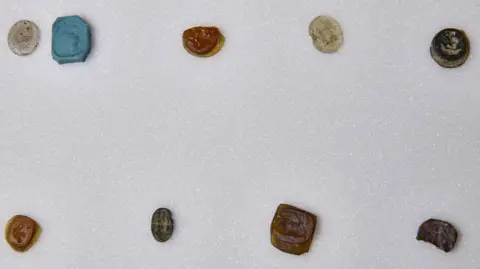British Museum finds 268 more missing artefacts
 British Museum
British MuseumThe British Museum said it has found hundreds of missing and stolen objects, bringing the total number of recovered items to 626.
The museum said up to 2,000 items had gone missing or were damaged, many of which were stolen from its storerooms and sold on eBay.
A spokesperson said the operation is now global, with objects found all over the world.
Last year, a senior member of staff suspected of being involved with the disappearance of the items was sacked.
Dr Peter Higgs was a senior curator in the museum's Greek and Rome department.
He has denied all the allegations.

Due to the lack of cataloguing and records, the museum has had trouble proving which of the recovered items came from its collections, so for now, it is receiving these objects back as donations.
Chair of the British Museum, George Osborne, said detective work from staff resulted in the latest recoveries, which are now back in the museum.
“Few expected to see this day, and even I had my doubts," he said.
"More than 600 of the objects are back with us, and a further 100 have been identified – in total almost half the stolen items that we could recover.
"When we announced the devastating news that objects had been stolen from our collection, people understandably assumed that was it - we were unlikely to ever see more than a handful of them again. That’s usually the history with thefts like this."
Cataloguing issue
A number of the pieces, which were never catalogued but the museum believes it owned, were sold on eBay for as little as a few pounds, and the true value of the items is still unknown.
Arthur Brand, an art detective who works with police to recover missing artefacts, says that like many museums worldwide, the British Museum has many things that are not fully recorded.
"I'm surprised, I didn't think it will they will recover these pieces so quickly and at all. Many were not catalogued," he told the BBC.
"This is not only the problem of the British Museum but a common problem in museums worldwide because of lack of funding and an impressive amount of items."
Control 'better than trust'
In an earlier civil court hearing, lawyers from the museum described how it believes the suspect altered internal records to try and cover his tracks.
The suspect edited at least 83 digital internal records which related to stolen, damaged or missing items, the court heard.
But much of the collection remains uncatalogued and many records, including of gemstones, don't have photos.
"We always think all these people are decent people in the museum, and if someone there abuses this lack of record keeping what can you do? You expect people not to steal. You can't give them a full body search every time they leave the museum."
Mr Brand said the key is to catalogue everything.
"Trust is good, but control is even better. A second database must be created that can not be accessed by staff, so things can be double-checked. Even if you have pieces in the catalogue people can alter it."
The British Museum was told at the end of 2023 to improve its records by an internal review following the thefts.
It said it would spend approximately £10 million to document its entire collection and make it available online within five years.
The Metropolitan Police is investigating but no arrests have been made.
